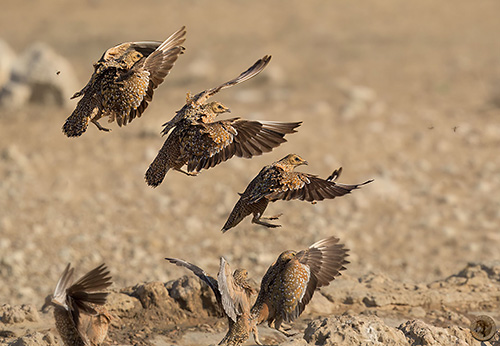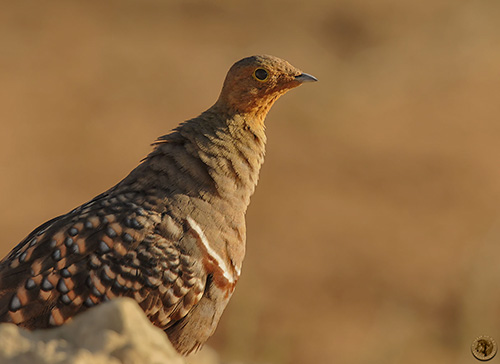
Fr: Ganga namaqua
Ang: Namaqua Sandgrouse
All: Namaflughuhn
Esp: Ganga Namaqua
Ita: Grandule del Namaqua
Nd: Namaquazandhoen
Sd: namaquaflyghöna
Photographers:
Didier Buysse
Vision d’Oiseaux
Callie de Wet
GALLERY
Jean Michel Fenerole
Photos d’Oiseaux du monde
Text by Nicole Bouglouan
Sources:
HANDBOOK OF THE BIRDS OF THE WORLD vol 4 by Josep del Hoyo-Andrew Elliott-Jordi Sargatal - Lynx Edicions - ISBN: 8487334229
BIRDS OF AFRICA SOUTH OF THE SAHARA by Ian Sinclair and Peter Ryan - Princeton University Press Princeton and Oxford - ISBN: 0691118159
BIRDS OF SOUTHERN AFRICA – By Ian Sinclair, Phil Hockey and Warwick Tarboton – Princeton Field Guides - Princeton and Oxford – ISBN: 0-691-09682-1
ROBERTS BIRDS OF SOUTH AFRICA by G. R. Mc Lachlan and R. Liversidge – The Trustees of the John Voelcker Bird Book Fund – ISBN: 0620031182
Structure and mechanics of water-holding feathers of Namaqua sandgrouse (Pterocles namaqua)
MIT News - Scientists uncover the amazing way sandgrouse hold water in their feathers
Biodiversity & Development Institute
The breeding biology of the Namaqua Sandgrouse, Pterocles namaqua
Creagus – SANDGROUSE Pteroclidae
Sandgrouse - From Wikipedia, the free encyclopedia
Wikipedia, the free encyclopaedia
Namaqua Sandgrouse
Pterocles namaqua
Pterocliformes Order – Pteroclidae Family
INTRODUCTION:
The Namaqua Sandgrouse is found in several arid regions of South Africa, Angola, Namibia, Zimbabwe, Botswana and Lesotho. The species is usually found in desert and areas of low rainfall where it can find seeds and have some access to freshwater source. It feeds mainly on seeds, but other food items such as leaves, flowers, small fruits, insects and molluscs are also part of its diet.
The Namaqua Sandgrouse is gregarious outside the breeding season, and large groups are seen at watering holes. They also spend the night in flocks.
This species may nest solitary or in small colonies. The nest is on the ground, a scrape lined with dried plant material. Both adults share the nesting duties.
The Namaqua Sandgrouse is described as common and locally abundant in much of the range. The main predators are mongooses and birds of prey, but the species is not globally threatened at the moment.

DESCRIPTION OF THE BIRD:
Biometrics:
Length: 28 cm
Wingspan: 50-52 cm
Weight: M: 170-190 g – F: 150-190 g
The Namaqua Sandgrouse differs from other sandgrouses by the long, pointed, black tail.
On the upperparts, the adult male has back and upperwing mottled brown and pale blue-grey with large specks. The flight-feathers are brownish but the secondaries are tipped white. Rump and uppertail-coverts are duller, mostly brown with pale buff spots. Two long, central, black filaments extend from the rounded, olive-brown tail. The rectrices are tipped-white.
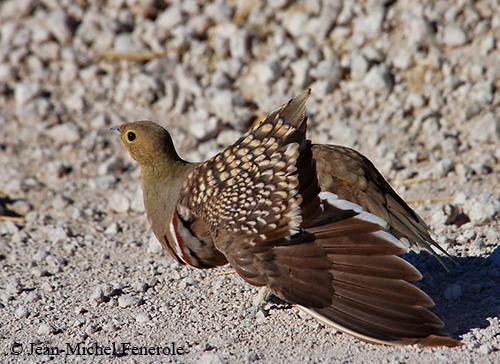
On the underparts, we can see a white and dark purplish-brown double breast band on the yellow-brown lower breast, the white band above the other. Belly, flanks and axillaries are uniformly dark greyish-brown, fading towards the rear. Thighs, vent and undertail-coverts are yellow-brown.
Head and neck area are uniformly yellow-brown. Face and throat are washed buffy-orange.
The bill is greyish. The eyes are dark brown, surrounded by yellow, bare eyering. The strong legs and feet are greyish.
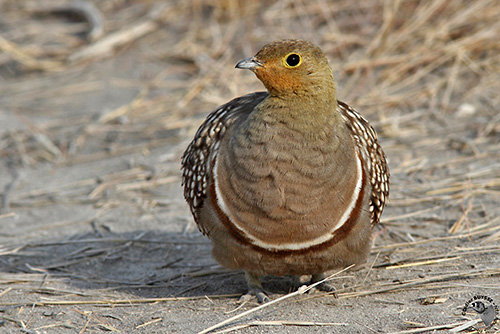
Both female and juvenile have more cryptic plumage.
The female has buffy-yellow plumage overall, with black-brown barring, streaks and mottling over the body. On the upperwing, the tertial coverts are broadly tipped white.
On the underparts, throat and upper breast show vertical streaks whereas lower breast, belly and thighs show dark horizontal bars. The axillaries are dark brown. The double breast band is absent. Vent and undertail-coverts are buffy-white.
On the buffy-yellow head, the eyering is paler, mostly bluish-grey.
The juvenile resembles female but it is more rufous above, with some white-tipped feathers.
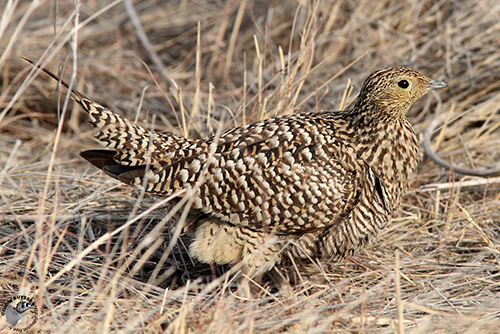
RANGE:
The Namaqua Sandgrouse is found in southern Africa, from SW Angola through Namibia to Zimbabwe and patches of Botswana, Northern Cape and adjacent provinces. It is especially common in the Nama Karoo and southern Kalahari.
HABITAT:
The Namaqua Sandgrouse prefers open stone and gravel desert and semi-desert, open dwarf shrubland and sandy savanna. The habitat has often rough vegetation and tussock-type grasses.
The species is well adapted to life in arid areas but it needs an access to freshwater source.
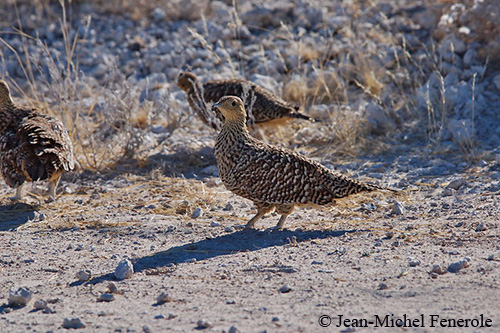
CALLS AND SONGS: SOUNDS BY XENO-CANTO
The Namaqua Sandgrouse has several types of calls.
The flight call is a nasal yelping “kwel-kee-weeen” and some variations. We can also hear a series of sharp “quip” when the bird takes off. The alarm call is “ki-kiii”. At the nest-site, a high-pitched call is given during nest-distraction display.
Within the groups, the birds call all together, and a constant nasal, gull-like squabbling is continuously heard.
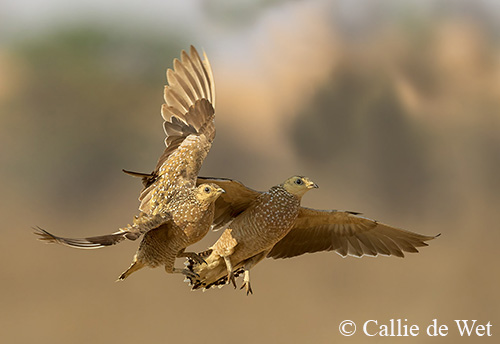
BEHAVIOUR IN THE WILD:
The Namaqua Sandgrouse feeds primarily on seeds of various plant species, and especially Leguminosae and Capparidaceae in the Namib Desert, or Chenopodiaceae in the Kalahari. Fresh leaves, flowers and small fruits are also taken, and some insects and molluscs are occasionally part of its diet. It swallows gravel and pebbles to help grind the seeds in the gizzard.
It drinks in the morning, and occasionally in late afternoon. They may travel up to 60 km each day to reach freshwater sources.
It forages during the day, singly, in pairs or small groups. It makes quick pecks at the ground while walking slowly. The bird is seen in a crouched posture and the head bent low. This species does not scratch the soil with the feet, preferring to flick the sand with the bill.
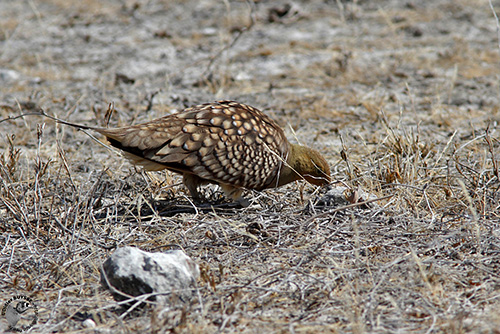
Like other sandgrouses, the Namaqua Sandgrouse has specially adapted feathers on belly and lower breast to absorb and hold water. The adults, especially the males, carry the water in these soaked feathers from which the chick drink during about two months.
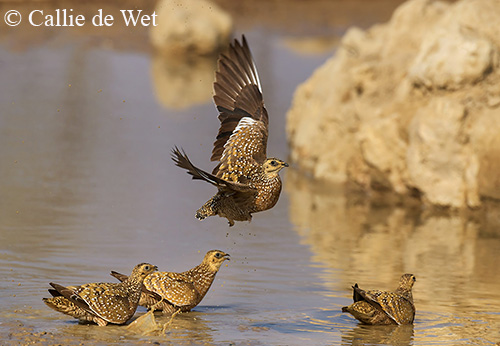
The Namaqua Sandgrouse roosts in stony areas, mainly in flocks. Each bird makes a scrape in which it spends the night. In cold weather, the birds rest close to each other.
During the breeding season, the species nests on the ground and both adults share the nesting duties. They often breed in small, loose colonies, with nests about 20 metres apart.
Predation by small mammals often causes up to 96% of nest losses.
The Namaqua Sandgrouse is monogamous. The courtship displays are simple. The male performs a strutting display during which it runs after the female. The tail is fanned out while the head is held tucked into the shoulders. The female may sometimes pursue the male. Prior to copulation, the female adopts a submissive posture.
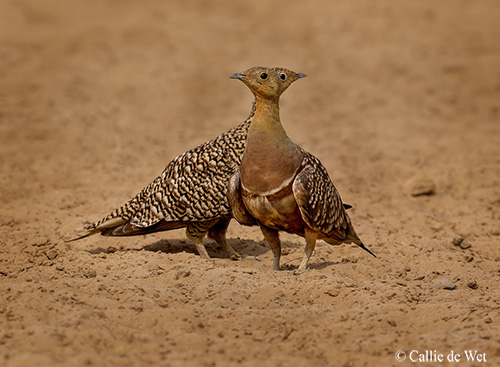
This species is nomadic and partially migratory, and the birds often move to Southern Kalahari in winter (May-August).
The southern populations are migratory and the birds breeding in Karoo move N to N Cape, Botswana and Namibia.
In flight, the relatively long and narrow pointed tail is conspicuous. The flight is fast, with an estimated cruising speed of 60-70 km/hr.
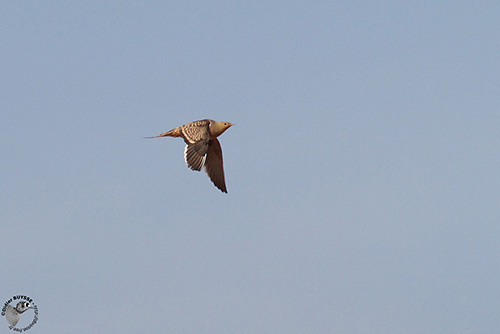
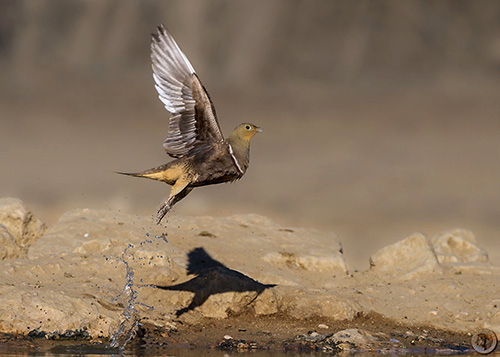
REPRODUCTION OF THIS SPECIES:
The breeding period probably depends on rainfall. It may occur in all months except February, with peak during late winter and spring.
The Namaqua Sandgrouse makes a scrape in bare soil or among stones, grass tufts or scrub, lined with dried plant material. It is usually exposed to the elements.
The species may breed in isolated pairs or in small, loose colonies. They are monogamous.
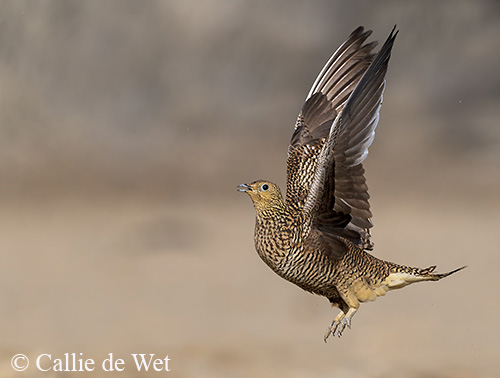
The female lays 3 pinkish-grey eggs with brown speckles. Both adults share the incubation (the male at night), during about three weeks. At hatching, the precocial chicks have yellowish-brown down with creamy and whitish markings. They are fully feathered at 3 weeks old, and able to fly at 6 weeks.
They eat the seeds pointed out to them by their parents. They drink the water carried in the belly feathers of the adults.
The main predators are the Booted Eagle, the Peregrine Falcon, the Tawny Eagle, jackals, snakes and mongooses.
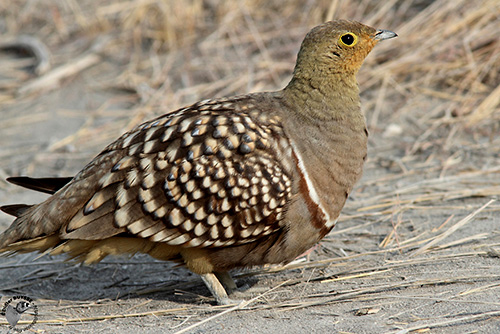
PROTECTION / THREATS / STATUS:
The Namaqua Sandgrouse is described as common to locally abundant in much of the range.
Decreasing hunting and availability of watering holes created by agriculture projects make a bright future for this species.
However, the species is now absent from Orange Free State and Lesotho, following severe drought and habitat destruction.
The population is suspected to be stable and the species is not globally threatened.
The Namaqua Sandgrouse is currently evaluated as Least Concern.
